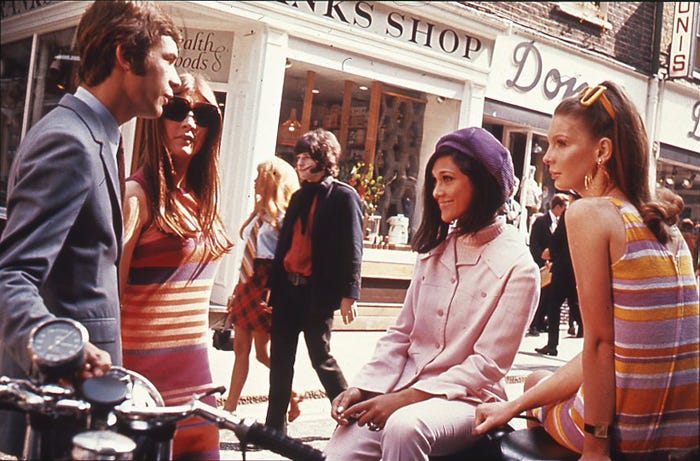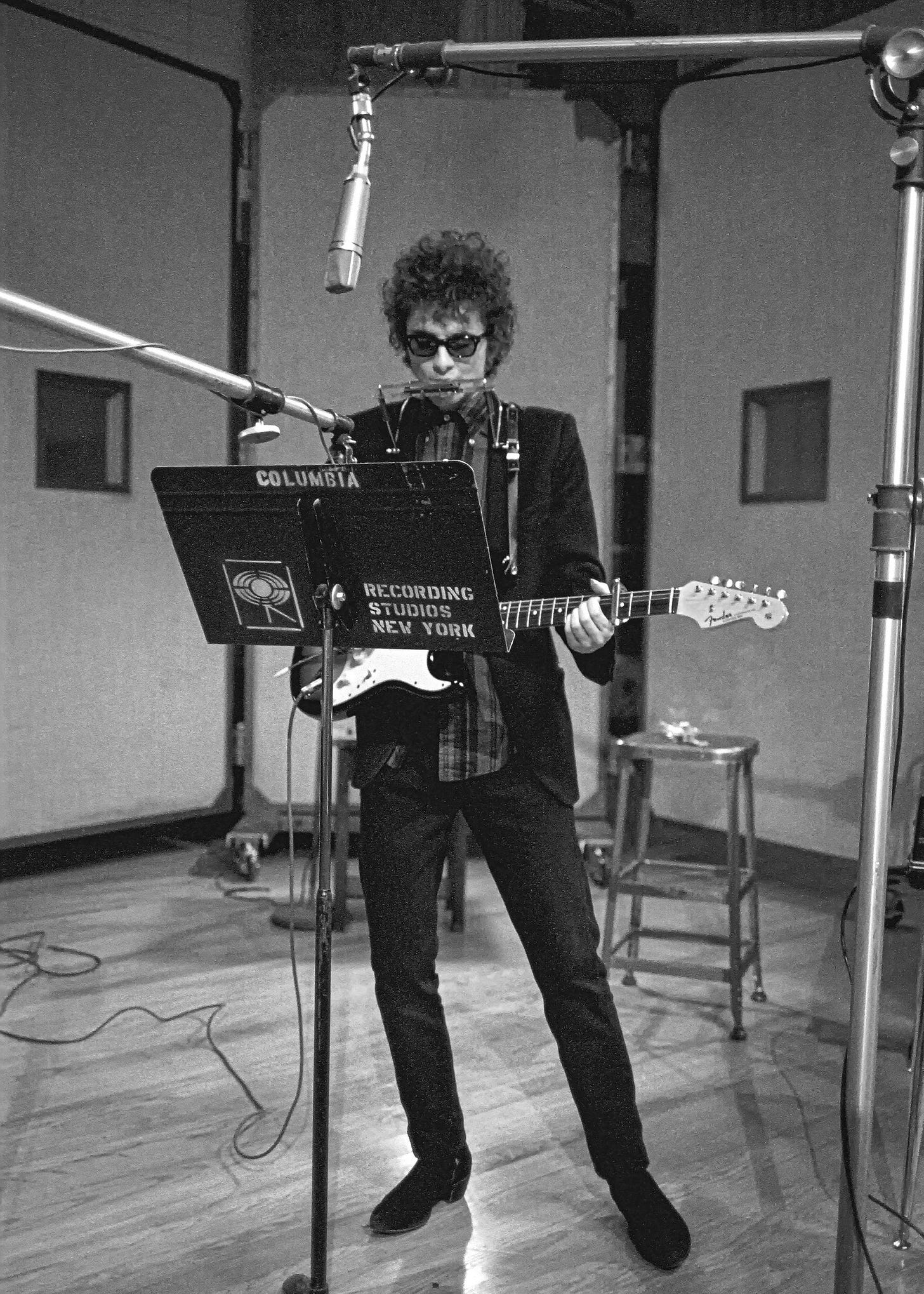The 1960s as a Modern-Day Style Reference and the Bob Dylan Film
If you see me finally give in to the allure of a suede jacket, this is why.
If you’ve happened to see any of my TikToks where I chat about the things I’m currently loving, chances are you’ve heard me ramble about the influence the 1960s has on my style. At least on my personal social feeds, people love to reference the 1970s and the 1990s when talking about fashion or when getting dressed, but I personally am of the belief that the 1960s are highly underrated as far as contemporary style references go.
There are, of course, the stereotypical pieces that people think of when they call this era to mind: the short shift dresses, the go-go boots, the bright hues. Beneath the surface, however, there is so much material to draw inspiration from.

First, a little bit of historical context. With the counterculture that arrived in the ‘60s came the then-revolutionary desire to dress in accordance with one’s own values, rather than simply replicating the staid outfits of older generations.
As Avery Trufelman describes in the podcast Articles of Interest (season 3, episode 4), the 20th century was defined by two overarching fashion eras (set out by French philosopher Gilles Lipovetsky). The first era was marked by the all-powerful designer, who dictated to their clients what they ought to be wearing. Fitting in was important. Then the 1960s hit, and young people of the day had had enough of dressing like their parents. Individuality reigned supreme, and counterculture movements brought with them entirely new ways of dressing.
To me at least, that’s what makes the 1960s as a fashion era so fun to reference. Everything was fresh, people experimented, and there is simply so much variety and source material to be inspired by.
We recently saw the Bob Dylan film, A Complete Unknown, which is set during the early years of Dylan’s career during the early-to-mid 1960s, and it made me think about how timeless and wide-ranging this era can be when it comes to fashion. As is typical for me with period films, my visually-oriented brain zeroed in on the costumes and weeks later, they’re still swirling around in my thoughts. I wanted to round up a few pieces that were popular during the period, plucked from the film, that are worth rediscovering today and have made me think differently about the pieces in my own closet.
The Cigarette Trouser. The sartorial preference, as far as trousers are concerned, in recent memory has tended towards the wide, flowy, and voluminous. No doubt a counter-reaction to the skinny jean trend of the 2010s, the wide leg trouser domination of the 2020s has been undeniable. In my mind however, there exists an entirely separate and criminally under-discussed third option: the cigarette trouser. The straight leg, structured, cropped-to-the-ankle trouser is the perfect middle ground, and features heavily in A Complete Unknown. At one point early in the film, Sylvie (played by Elle Fanning) wears a black cigarette trouser with a burgundy peacoat and ballet flats: no doubt an outfit I would wear today in 2025. We collectively love our straight leg denim, so consider this my petition to bring back the straight leg trouser.
Pleated Skirts. There’s one scene in the film where Joan Baez (played by Monica Barbaro), while on stage at the 1964 Newport Folk Festival, dons the most incredible ivory pleated midi dress. Hear me out: I know the pleated midi skirt is having a slight moment currently, but it’s a piece with so much styling potential that I’ve unintentionally pigeon-holed into a certain schoolgirl/Miu Miu/Sandy Liang aesthetic. I was taken by how conservative the piece was for a rising folk star, but the suede fringe jacket over top instantly gave the look a much-needed edge. Looking to previous eras and subcultures for a different perspective on styling pieces I may not be utilizing to their full potential is one of my favourite ways to play with my closet, so if you catch me wearing my navy pleated skirt with some suede, you’ll know exactly why.
Bold Eyewear. Eyewear trends ebb and flow across the years, but if one thing remains constant, it’s a pair of chunky, black sunglasses. Perennially cool and loved by fashion icons from Bob Dylan to Audrey Hepburn to Harry Styles (the inspiration behind asking my parents for Ray Ban Wayfarers for my 16th birthday), the style is a classic. As a recent entrant to the prescription eyeglasses club, only in the past couple of years have I paid any attention to eyewear and the power a good pair of frames can have. These days, it’s one of the first things I notice when I’m watching a film. Dylan wears his signature black sunglasses throughout the second half of the film, indoors and out, and they’re simply iconic. The film also features lots of elongated rectangular sunglasses (not a style I would have ever gone for but am now intensely intrigued by) and cat-eye frames (a longtime personal favourite and 1960s classic).
Suede Jackets. With each autumn that rolls around, so too do the videos proclaiming suede jackets to be the next big trend of the season. For that reason I know suede jackets are hardly groundbreaking, but the ones in the film were simply so good. For better or worse, I’m the type of person to tune out items once they’ve hit critical mass, and so the suede jacket has truthfully been off my radar for quite some time. And then came the shot of Joan on stage in the aforementioned suede fringe jacket, and the numerous scenes of Bob in his hip-length shirt jacket-esque iteration, and my eyes were opened. The suede jackets we think of today are perhaps more in line with the ‘70s than the decade in question, at least in my mind, with their super oversized cuts and boho touches. If I do begin a quest for the perfect suede jacket, I’ll be looking for something with more of a ‘60s bent — maybe slightly cropped and definitely a little bit boxy.
It’s been less than two months but I’m already looking forward to re-watching A Complete Unknown (not only because of the costumes!), so if you haven’t seen the film yet I highly recommend it.
Thank you ever so much for reading. Until next time!
x
Victoria








Hi, from another Victoria 😊 I also loved the recreation of 1960s fashion in the movie. However, I felt everything looked too neat, clean and polished. People back then were more... shabby and women didn't look like just out of the hairdressers. I don't know. Joan Báez was a hippie! I do want to rewatch it soon so I can pause and pay attention to details. There was so much to see! Those NYC streets! (which were actually filmed in New Jersey, ha)